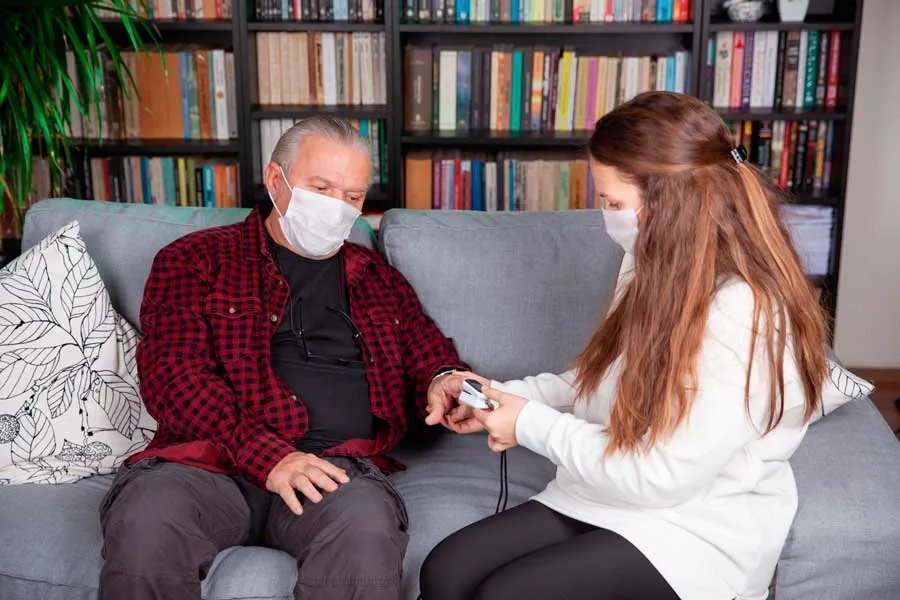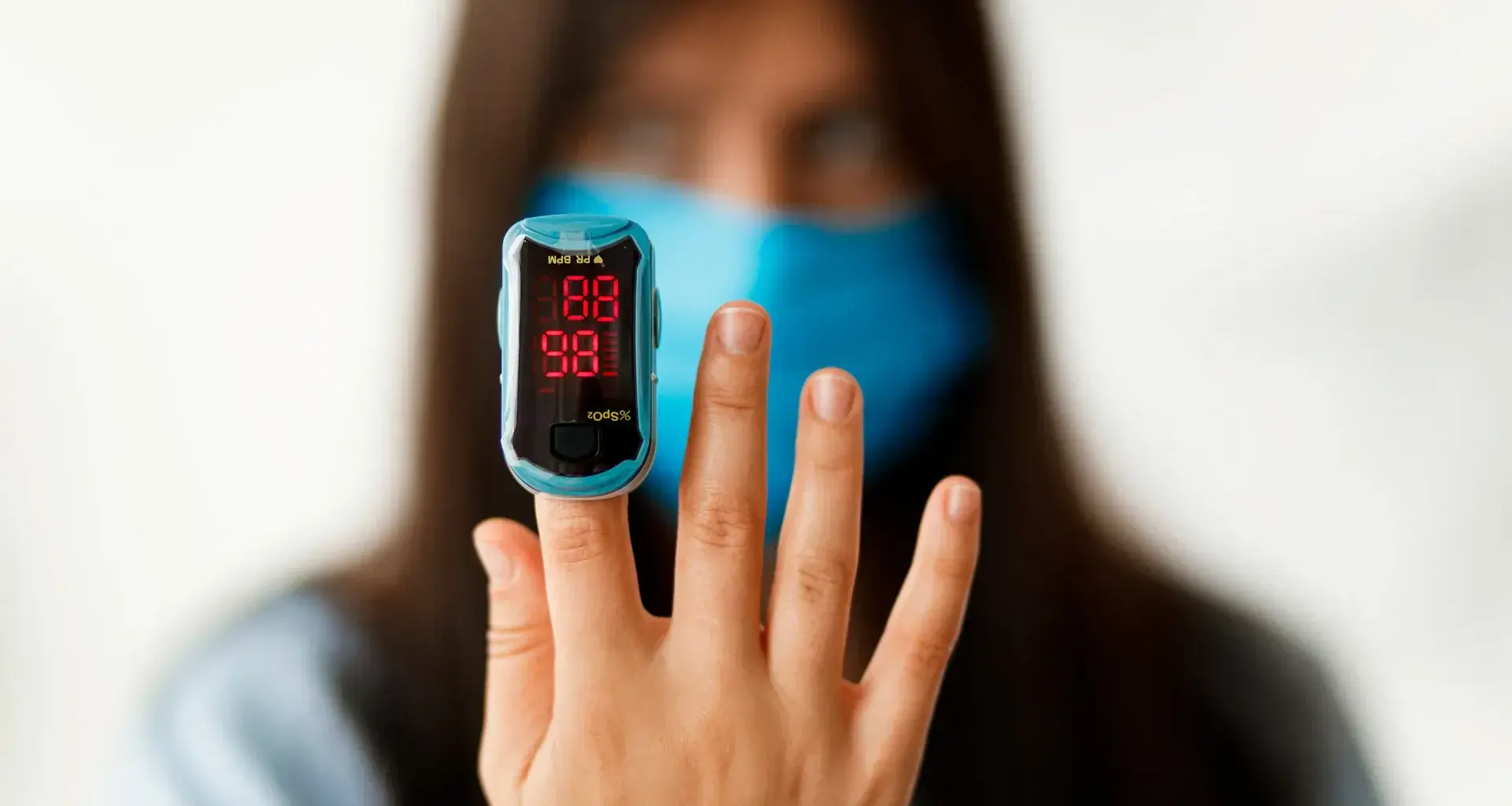Why is it essential to measure the oxygen of COVID-19 patients?
Dr. Tania Zertuche, academic director of the Internal Medicine specialization program and member of TecSalud’s COVID patient care team, explains this to CONECTA.
“Oximetry is an indirect way of measuring the concentration of oxygen in our blood, i.e. what percentage of your blood is carrying oxygen,” explains the specialist.
She adds that this can be done at home using an oximeter, a small device with a built-in clamp that sits on your finger.
Using this device, you can quickly and easily measure your oxygen levels and determine whether you need to seek medical help, which you should if they’re lower than 92%, she emphasizes.

The specialist points out that one of the most serious effects of COVID-19 is inflammation of the lungs, which could lead to pneumonia.
“I need to clarify that pneumonia doesn’t occur in all COVID cases. But when it does occur, it means oxygen exchange doesn’t take place correctly and that means there isn’t a high enough concentration of oxygen for the body’s molecules,” she explained.
Here’s what you need to know to measure your oxygen levels
- When should I start monitoring it?
Dr. Zertuche says it is important to monitor your blood oxygen levels if you have been diagnosed with COVID or suspect that you are infected.
“If we show symptoms, it’s best to do the test. Once we get a confirmed diagnosis, we should monitor oxygen saturation with a pulse oximeter,” she said.
She emphasizes that if you have a positive diagnosis, you should seek medical help and follow instructions given by medical professionals.
What is the minimum oxygen level?
Dr. Zertuche explained that normal oxygen levels are as follows:
- At least 95% for healthy people
- At least 92% for those who have been diagnosed with COVID-19
- What if I have COVID and an oxygenation level over 92%?
“In COVID cases, as long as the level stays above 92%, patients can stay at home without the need for supplemental oxygen.
“You need to monitor your oxygen saturation. You should know what your normal level is and check to see if your oxygen levels are dropping,” she suggests.
It is recommended that patients be monitored in hospital if they have oxygen levels of 92% or less.
- What warning signs should I know about?
The TecSalud specialist says there are characteristic symptoms of oxygen saturation beginning to drop or going below the normal level. These could be:
- Feeling short of breath
- Dizziness and/or nausea
“If you can normally do certain activities -like going up stairs- without feeling short of breath, and then you suddenly start to notice that you’re tired or short of breath, it could be a symptom,” she says.
However, she says that this sensation can also be caused by other conditions that are unrelated to COVID-19, such as being physically unfit.
- What will happen to me if my oxygen levels are low?
Having lower than normal levels of oxygen saturation in the blood for short periods of time does not cause any damage, but if sustained, this can damage or put excessive strain on your body’s cells.
- What are the options for measuring oxygen levels?
Dr. Zertuche says that there are several ways to measure your body’s oxygen levels:
- Pulse oximetry
This is one of the most practical and user-friendly options for measuring your oxygen levels and heart rate (pulse) at home during the pandemic.
“A pulse oximeter takes a measurement of our pulse and the blood that reaches our finger using red or infrared light. This allows the device to make an approximation of the oxygen saturation in our blood,” she explains.
The device takes the measurement without you feeling anything. You can ensure the oximeter is working properly by taking your pulse for one minute and seeing if it is the same as the oximeter reading.
- Blood test
The specialist points out that you can also take a blood test to find out your blood oxygen levels. However, although it is more precise, this process is more common for hospitalized patients.
“It involves puncturing an artery so we can see precisely how our body is handling oxygen. It wouldn’t be feasible for someone who’s in isolation to do this.
“Sometimes in hospital, especially with patients who are intubated, this process is used to really know if the treatment offered is providing greater oxygenation,” she says.

The oximeter: the best option for monitoring oxygenation at home
Dr. Zertuche says that a pulse oximeter is the most practical option for monitoring your oxygen levels at home.
“These devices are becoming more available and they’re easy to use. This is the easiest and simplest way to be able to assess oxygen saturation in our blood,” she points out.
Zertuche shared some tips for improving how we use them to get more accurate results:
- Avoid using nail polish
This can make a 1-2% difference to your oxygenation results.
- Properly clean the device
If several people in your family are using it, adequately clean it between use.
- Wait a few seconds for the analysis
You should wait at least 20 seconds for accurate results once you put it on your finger.
- Check that the batteries are in good condition
If they are not charged, they could cause device failure or generate inaccurate diagnoses.
- Avoid physical exertion
For example, after doing physical activity, take a moment to return to your normal state before you do the test.
- Maintain the correct posture
It is recommended to do the test while sitting and placing the device correctly on your index finger.
- You can take the reading at any time of the day
If you have been diagnosed with COVID-19, you should test every 8 hours.
- Take other factors into account
A fever, low blood pressure, or severe anemia are factors that can lead to imprecise diagnoses. Also take into account your age, hemoglobin level, and even the altitude of the place where you live.

What should I do if my oxygen levels start to drop?
Dr. Zertuche points out that only 15-20% of people diagnosed with COVID-19 suffer a decrease in their oxygen levels.
Some people even have the so-called “silent hypoxia”, in which there are no severe symptoms like shortness of breath, but they do have levels below 92%.
To avoid this, you should monitor your oxygen levels and seek medical help as soon as possible if they drop.
“It’s unusual for patients to get pneumonia within the first 7 days of infection. This usually only occurs after day 7 of the onset of symptoms, so it’s important to know our base oxygen levels and check to see if they’re dropping.
“As long as we keep levels above 92%, treatment can continue at home without the need for supplemental oxygen,” she adds.
“As long as we keep levels above 92%, treatment can continue at home without the need for supplemental oxygen.”
Should I administer oxygen to myself?
The specialist emphasizes that oxygen levels can drop from one day to the next, so she recommends going to a hospital immediately and not giving yourself oxygen until it has been medically prescribed.
“At TecSalud, we recommend monitoring at a hospital when there is need for supplemental oxygen.
“We’ve seen patients who’ve been using an oxygen concentrator at home to keep their saturation levels above 93%. However, there are cases in which this delay reduces the symptoms a little and they can get to the hospital in a worse condition,” she says.

So, when should I use supplemental oxygen?
Oxygen concentrators and tanks should only be used under the supervision and recommendation of medical personnel, warns Dr. Zertuche.
“We don’t recommend starting the use of oxygen at home if there is no medical supervision. The World Health Organization recommends that you go to hospital when you need oxygen,” she points out.
She explains that its use by patients who have already been hospitalized and who are out of danger of severe pneumonia should be controlled and personalized by health specialists.
“We really only suggest its use for patients who have already been to hospital, who have already received treatment, who are out of danger, or have already recovered from severe pneumonia.
“Some patients may need to go home with an oxygen tank or concentrator. We do have patients who return home with oxygen to avoid prolonging their stay in the hospital. The treatment is carried out at home (under supervision),” she concludes.
COVID-19 is the name of the disease caused by the SARS-CoV-2 coronavirus. It was first detected in China in 2019 and spread throughout the world causing a pandemic in 2020.
The disease mainly spreads from person to person via droplets expelled from the nose or mouth of infected people when they cough, sneeze, or talk. You can also get infected by touching surfaces that have the virus on them with your hands and then touching your mouth, nose, and eyes.
The most common symptoms are a cough, sore throat, and fever. 80% of cases do not require hospitalization. Severe cases display symptoms such as shortness of breath, pain or tightness in the chest, or difficulties speaking or moving. In these cases, medical help should be sought.
Basic prevention measures include frequent hand washing, the use of face masks, and maintaining a distance of one and a half meters between people.
Do you need help?
If you have questions about COVID-19 treatment, you can contact TecSalud:
- Email: covid19@tecsalud.mx
- WhatsApp: 818 888 0775
In addition, if you belong to the Tec de Monterrey community and want to speak to a doctor or obtain psychological assistance at no cost, you can use the TQueremos hotline 24 hours a day, 7 days a week:
- Tel: 800 8139 500
- Web: tec.orienta-me.com
- App: Orienta (for both iOS and Android - register with your payroll or enrolment number)
YOU’LL DEFINITELY WANT TO READ THIS TOO:





